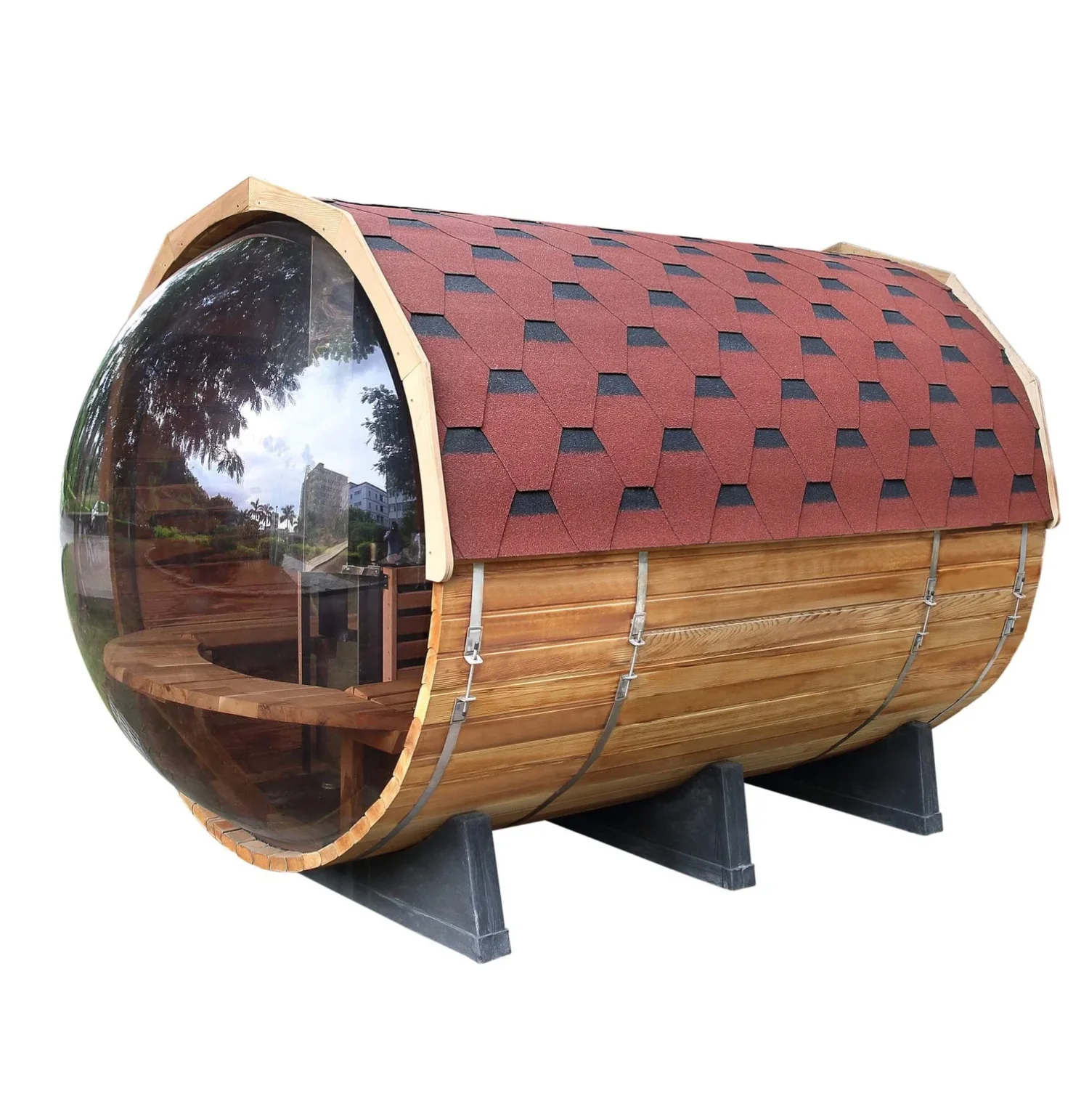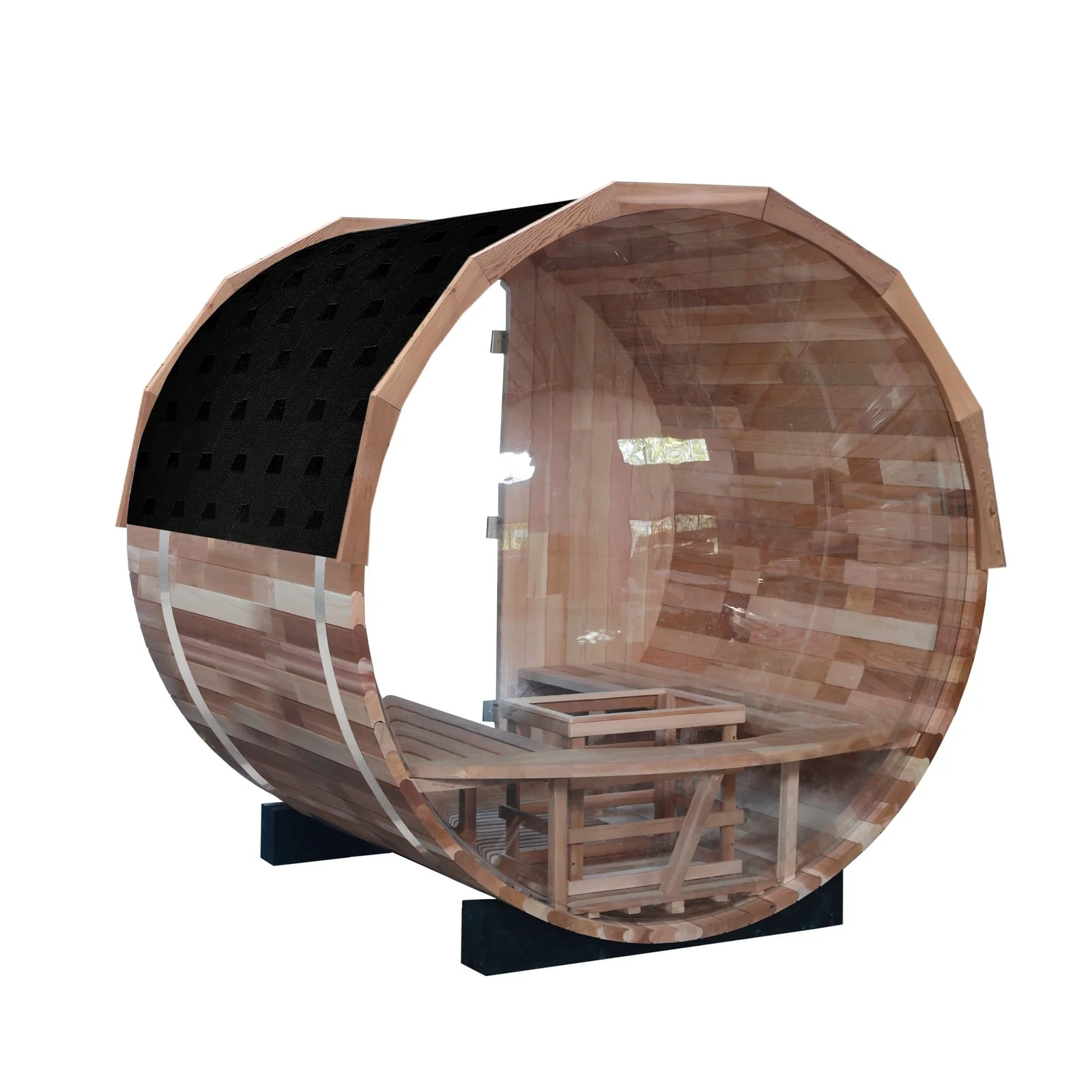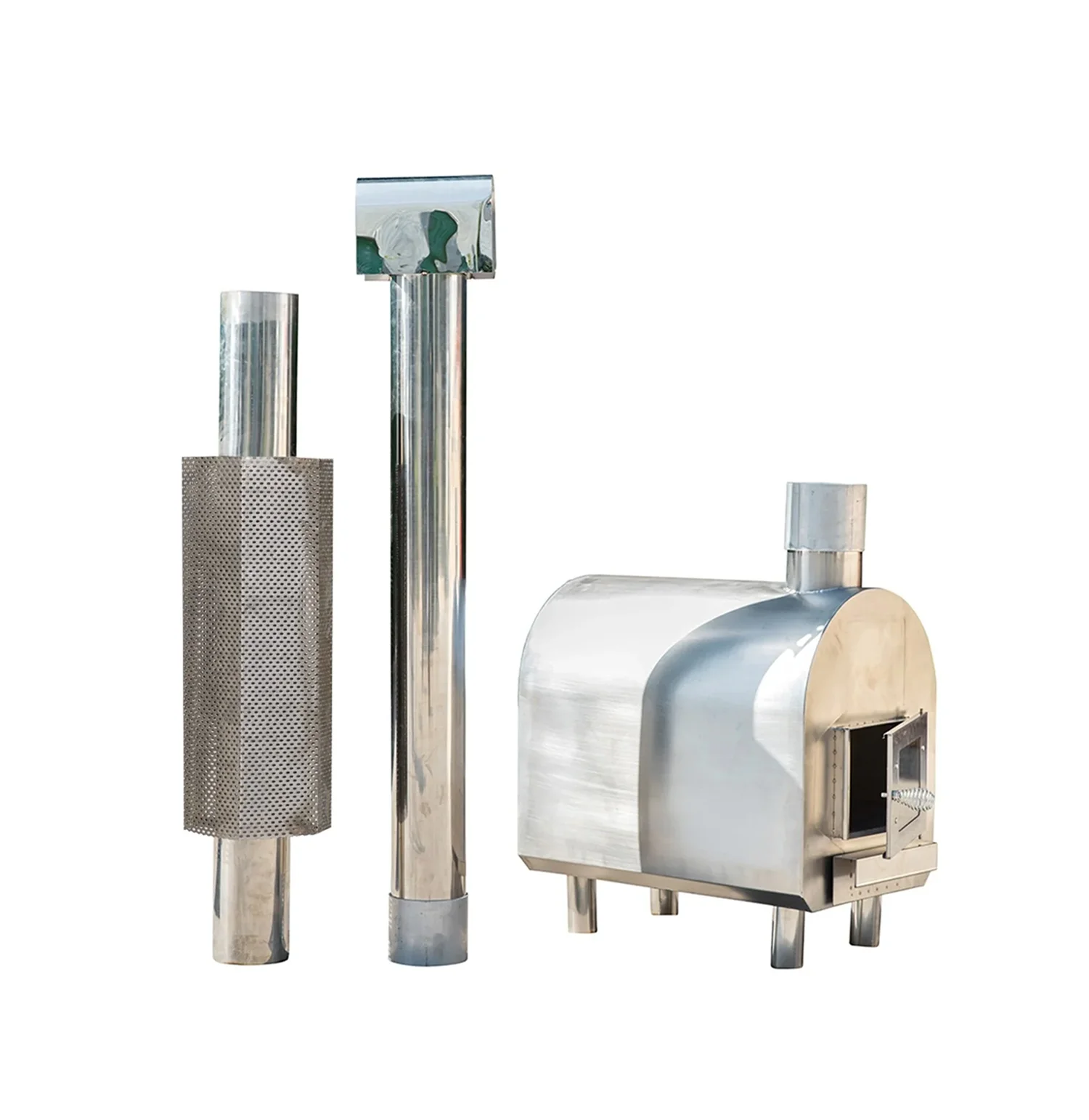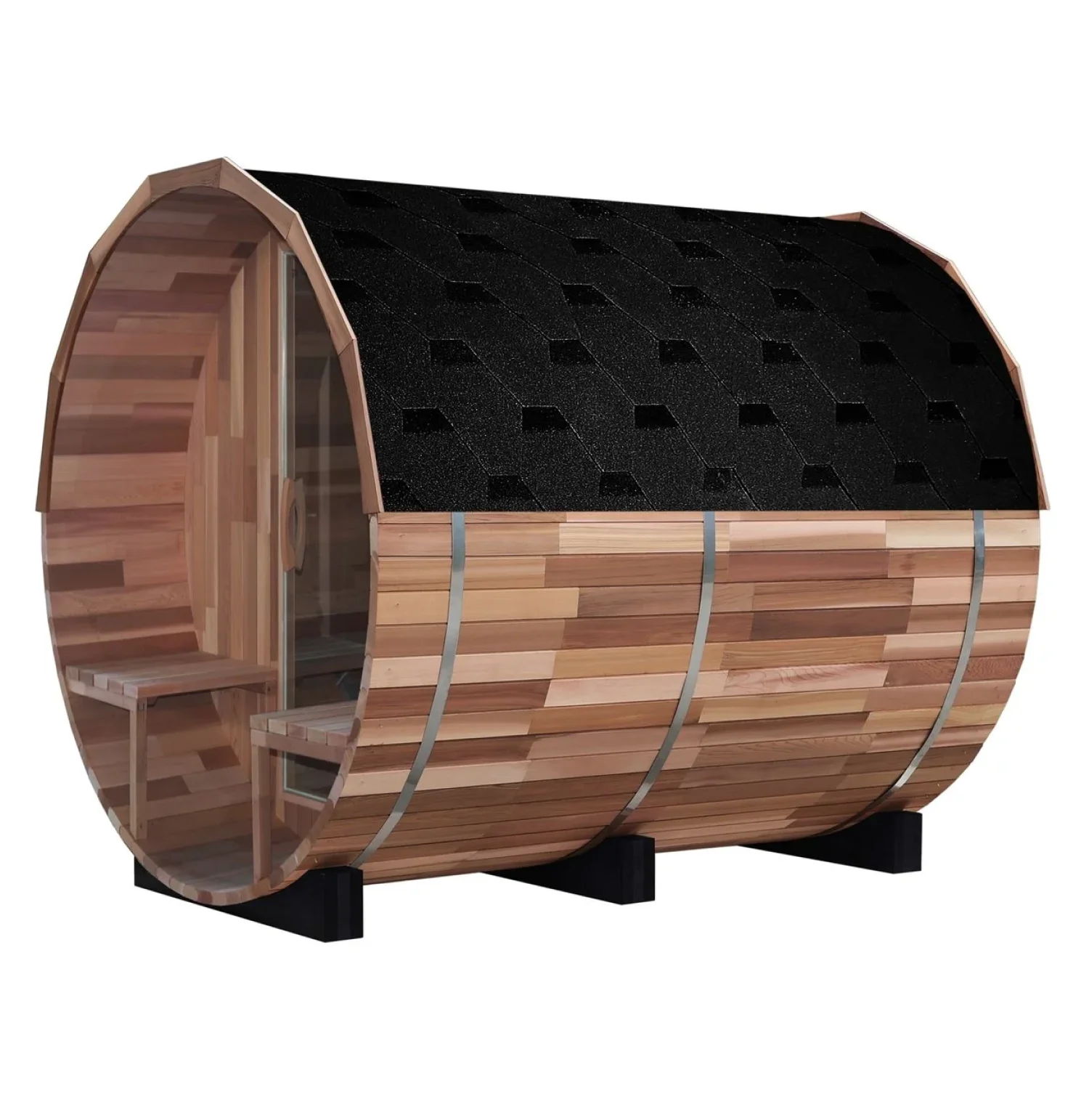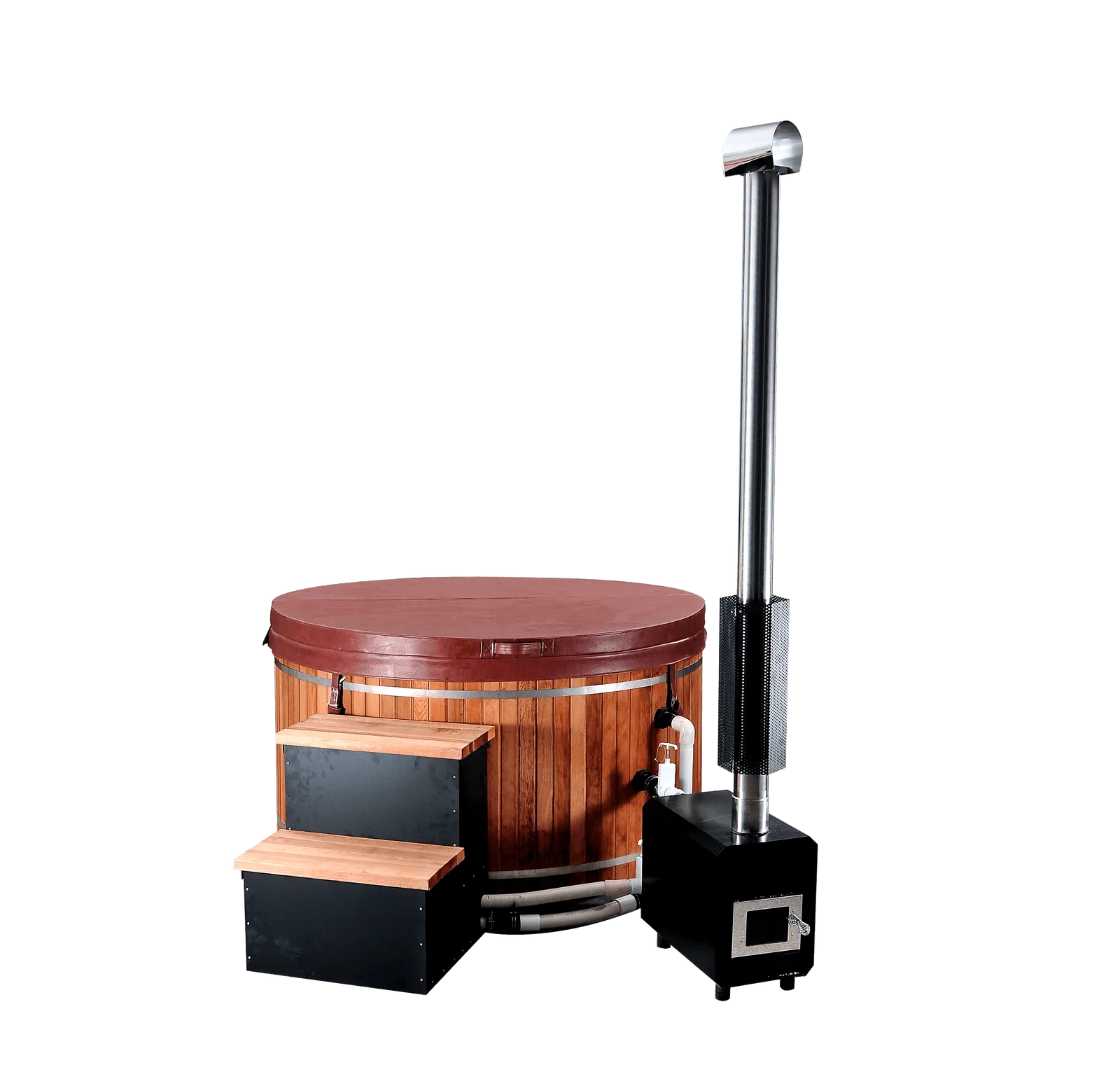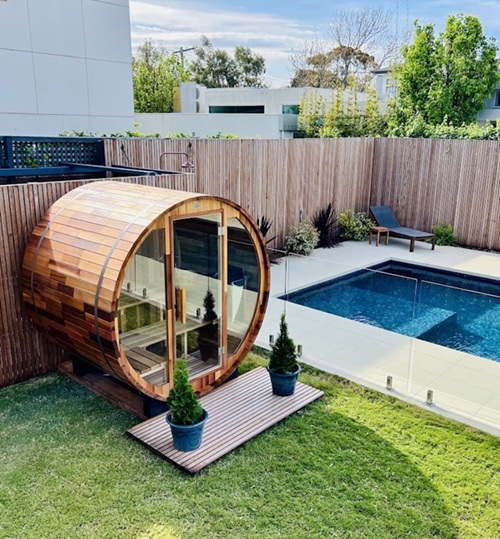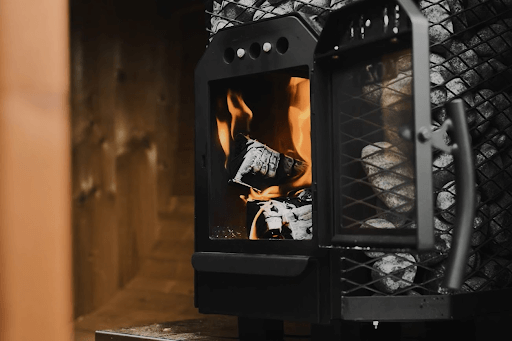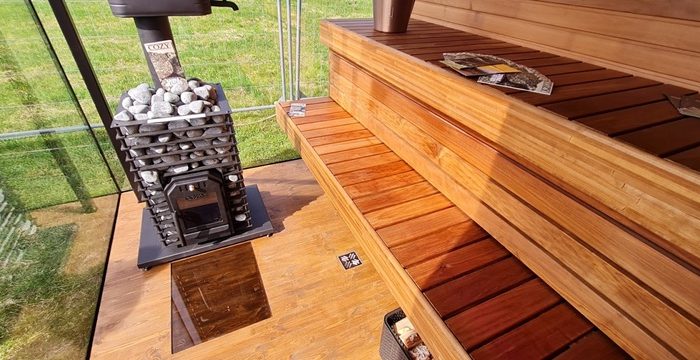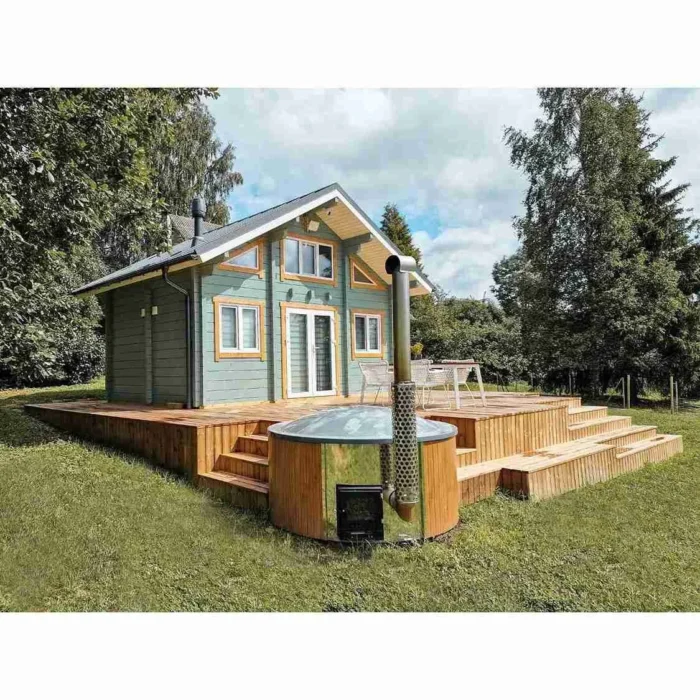Warming a sauna with a real, cosy wood-fired heater for soft, radiant warmth is about creating a sanctuary of smiles, connection and wellness, a place where family and friends can gather, feel the steady pulse of efficient heat and share meaningful moments.
At Shym Saunas, founders Artem and Elena understand this ritual intimately,
“When we moved to Australia we missed the glow of our Finnish‐style sauna so much that we built one ourselves!”
Today, Shym Saunas designs saunas and hot tubs that blend handcrafted Nordic spruce, thermowood and quiet luxury into Australian homes.
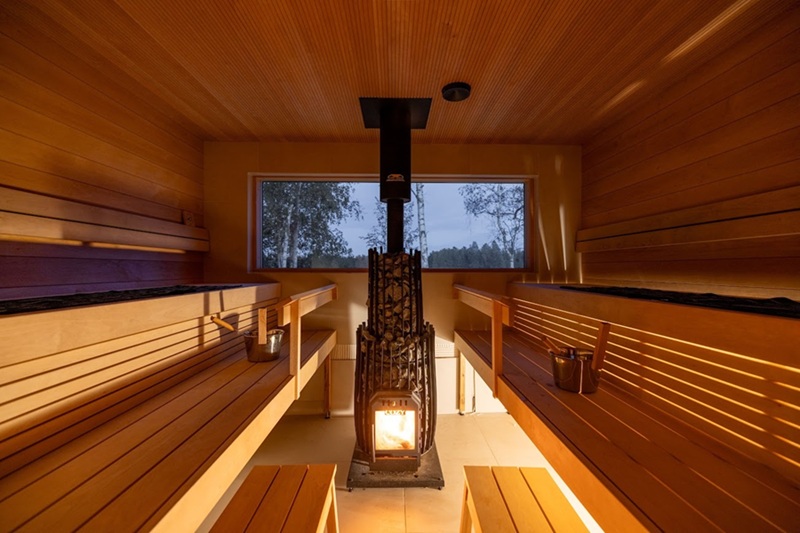
Photo Credit: Shym Saunas
This guide will help you plan your sauna sessions by explaining how long different sauna types take to heat, why times vary and how to make the most of every warm embrace. We’ll also look at how long wood‑burning saunas stay hot and how Finns measure sauna temperature.
Key takeaways
- Quality heat takes time. In a well-built Finnish sauna with a correctly sized heater, expect ~30–60 minutes for the stones and room to stabilise around 70–90 °C. Faster isn’t better—stones must be heat-soaked for soft, pleasant löyly.
- Infrared cabins warm up in 10–15 minutes and steam rooms in 15–30 minutes.
- As a rule of thumb, aim for 1 kW of heater power for 1.25 – 1.5 cubic meters of space helps ensure efficient heating.
- Underpowered = sluggish heat and thin steam;
- Overpowered = quick hot air but harsh bathing.
- Wood-burning saunas involve a startup ritual (lighting and establishing draw). Once the fire is clean and the stove is correctly sized, expect ~30–60 min to stone readiness—similar to electric. Proper chimney draw, ventilation, insulation and seasoned wood are the “four horsemen” of an efficient wood‑fired sauna.
- Measure like the Finns – then trust löyly. Place the thermometer ~15 cm below the ceiling above the benches. Use numbers as guidance, but let the quality of steam and your body’s feel decide when it’s truly ready.
Why “how fast” is the wrong question (experience-led)
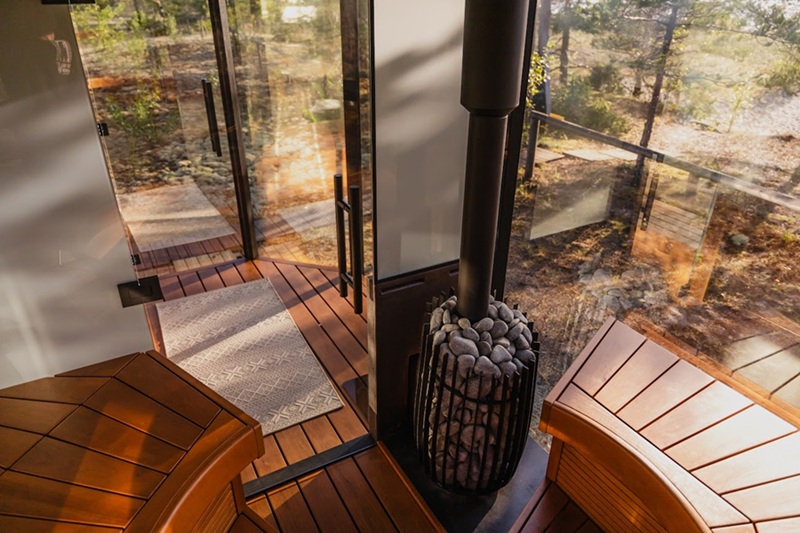
(Artem, our co-founder, stresses this point from years of installations and customer coaching: aim for stone readiness, not just a fast air temperature.)
“Many people think that a good sauna heats up fast. This is a misconception. A good sauna is one that provides a good sauna experience. To achieve that, you need to make sure the sauna stove stones are at the right temperature – not too hot and not too cold.
That’s why it takes 40 to 60 minutes to heat the stones to the proper temperature.
- If your heater is overpowered, the space will heat very quickly, but the stones won’t be ready. The sauna experience will be harsh: too hot and uncomfortable.
- If your sauna heater is underpowered, the heating will take too long, and you will never get to the right temperature. This experience will be bad.
- If your sauna heater is sized correctly, it will take 30 to 60 minutes.
This is how long it takes to heat the stones for an optimal experience.
So, for many experienced sauna users, the question ‘how long does it take to heat the sauna?’ is fundamentally flawed. A good sauna, where the heater and room are paired correctly, takes 30 to 60 minutes to prepare.”
Why the type of sauna matters
The heating time is largely determined by the technology and tradition behind your sauna.
- A good traditional sauna, whether electric or wood‑heated, operate at 70–90 °C and may need 40–60 minutes to reach a comfortable temperature.
- Infrared saunas heat the body directly rather than the air; they run at 38–65 °C and begin to feel therapeutic within 10–15 minutes.
- Steam saunas are cooler (30–50 °C) but usually reach temperature in 15–30 minutes.
| Sauna type | Estimated heating time | Notes |
| Traditional electric (Finnish) | 40–60 min | High air temperature and humidity; ideal for deep sweat sessions. |
| Wood‑burning | 45–60 min plus fire‑starting time | Requires lighting and tending the fire; heat quality depends on stove, insulation and wood. |
| Infrared | 10–20 min | Heats the body directly; lower air temperature is gentler. |
| Portable sauna tent | 15–30 min | Compact, often infrared; convenient for small spaces. |
And, if you want a family‑sized traditional sauna that heats efficiently, consider Shym’s PATIO L. Built in Europe from thermo‑treated Nordic spruce, its insulated cabin and split‑level benches help it reach temperature smoothly while offering room for 4–8 people.
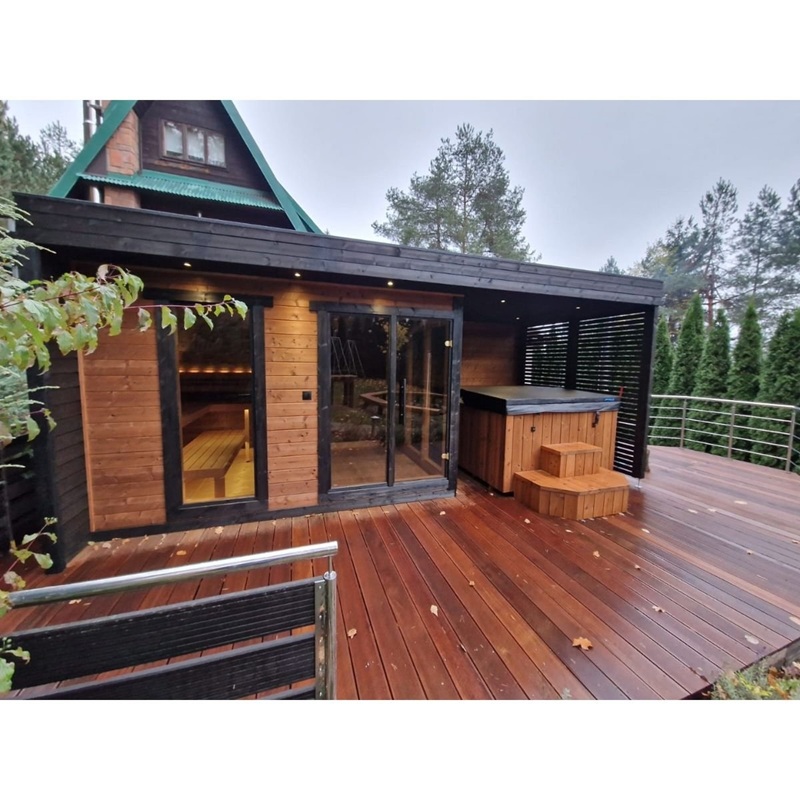
Size, capacity and heater power
A common misconception is that a smaller sauna should heat up faster than a larger one, with some expecting a 1-2 person room to be ready in 15-20 minutes. This thinking focuses on air temperature, not the quality of the sauna experience.
As our co-founder Artem explains, this approach is flawed and leads to a poor result.
“This is coming back to my point above,” Artem notes, “that the good experience implies that the stones are at the right temperature, and therefore it always takes 30 to 60 minutes to heat the sauna space to the right temperature, regardless of its size.”
The goal is not to heat the air as fast as possible, but to properly heat the stones.
- If it takes less than 30 minutes: “That most likely means that the heater is overpowered, or oversized,” Artem warns. “The air will feel scorching, but the stones won’t be ready. This ‘sauna experience’ is going to be harsh and uncomfortable.”
- If it takes more than 60 minutes: “Then the heater is most likely underpowered and undersized. You will struggle to get the right temperature, and the experience will be bad.”
Therefore, the key is to correctly match the heater’s power to the room’s volume to achieve that 30 to 60-minute “golden window” for stone heating. The general rule is about 1 kilowatt (kW) of heater output for every 1.25 – 1.5 cubic metres of room volume.
Tip: minimise heat loss so you don’t have to oversize the heater. A well-insulated cabin (e.g., our Outdoor Spruce Log Sauna CUBE) with a proper rock load retains heat longer and keeps löyly soft—without chasing speed or wasting electricity.
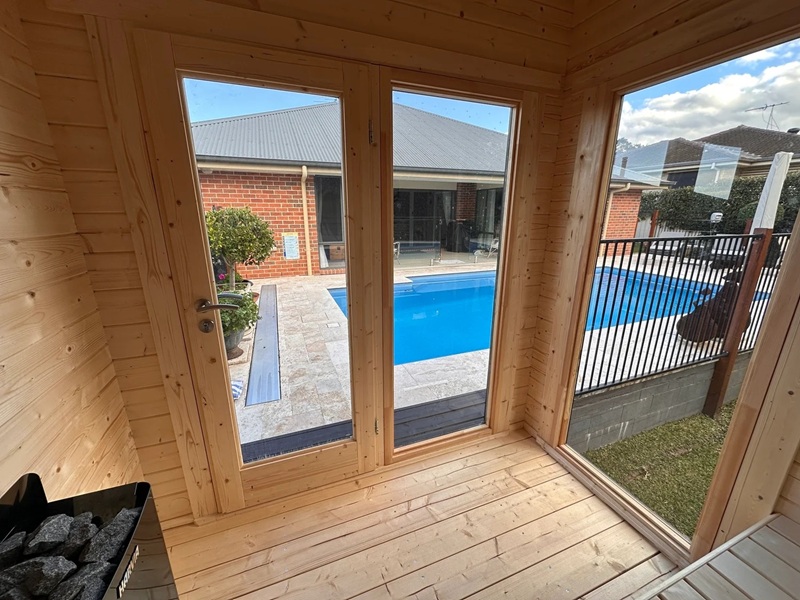
Insulation and construction
Heat loss is the enemy of quick warm‑up. Good insulation acts like a thermal barrier, trapping heat inside the cabin and keeping cold air out.
Materials such as fibreglass or mineral wool are commonly used in quality sauna kits, and the walls of Shym Saunas are lined with foil‑backed vapour barriers to reflect warmth. A poorly insulated barrel or backyard sauna may take longer to heat and struggle to maintain temperature on cool nights.
An airtight door and properly sealed joints also prevent heat from escaping. If your sauna takes too long to heat, check for gaps around the door or between logs, and consider upgrading insulation.
Ambient temperature and ventilation
Outdoor temperature plays a bigger role in free‑standing saunas than in an indoor cabinet. Cold weather draws heat away from the sauna, slowing warm‑up.
- On hot summer days, the opposite is true – the cabin heats faster. To minimise these swings, insulate well and avoid placing outdoor saunas in exposed, windy positions.
A balanced ventilation system brings in fresh air and exhausts stale air without stealing heat. Proper air intake and exhaust allow warm air to circulate, helping the heater work efficiently. Poor ventilation can trap humidity and slow heating, so ensure the vent size and placement follow manufacturer guidelines.
How long do wood‑burning saunas stay hot?
The comforting crackle of wood and the scent of smoke lend a ritualistic charm to wood‑fired saunas. However, they require patience and skill.
- Lighting the stove, waiting for the chimney to draw properly and tending the fire adds 10–15 minutes to the heating process.
- Once heated, a well‑insulated wood sauna can stay hot for 1–2 hours with minimal refuelling, though this varies with stove size and wood quality.
According to sauna expert Glenn Auerbach at Saunatimes, 4 key factors make or break a wood sauna’s heat:
- Draw: a tight chimney and straight flue ensure air is pulled through the firebox. Leaks or too many bends slow the draw and extend heating time.
- Ventilation: the fire needs ample oxygen. Poorly vented cabins suffocate the flame; ensure adjustable vents supply fresh air.
- Insulation: thick walls and a foil vapour barrier help the stove’s heat penetrate the stones and benches rather than escaping.
- Good wood: burn well‑seasoned logs (about 20 % moisture) for steady BTU output; avoid overly dry or green wood.
With these factors in place, a quality stove can bring a 6 m³ sauna to temperature in about 45 minutes and maintain it for 2 hours or more. Shym’s Western Red Cedar Barrel Sauna with Panoramic Glass couples a spacious barrel design with an efficient wood stove; its thick cedar walls store heat, allowing extended sessions without constant stoking.
For quick heat‑ups, choose hardwood species like birch or oak for fuel, and pre‑heat the stove with a small “chimney fire” to establish draw.
How do the Finns measure sauna temperatures?
Mount the thermometer ~15 cm below the ceiling above the benches, away from direct steam bursts.
Finns also monitor humidity with a hygrometer, keeping relative humidity around 10–35%.
Yet many sauna goers still trust their senses. The true measure of a sauna, as my Finnish mentor once told me, is how the löyly feels when you throw water on the stones.
- Does the steam envelop you like a warm blanket?
- Do you need to step down a bench to catch your breath?
These sensations tell you when the sauna is ready far better than any number on a dial. In our own Shym Sauna Cabins, you’ll find handcrafted thermometers and hygrometers to honour this tradition while ensuring safety.
Tips to reduce heating time and improve efficiency
Even the most efficient heater benefits from thoughtful habits. Here are some expert tips to help your sauna warm up quickly and stay cosy:
- Pre‑heat with purpose. Turn on electric heaters 20–30 minutes before you plan to enter; for infrared, 10 minutes may suffice. For wood stoves, light a small fire early and add larger logs gradually to build a strong bed of coals.
- Keep the door closed. Opening the door repeatedly during warm‑up lets heat escape; do your prep (towels, water ladle, music) beforehand and only enter when ready.
- Maintain your heater. Clean ash from wood stoves, tighten electrical connections and replace heater stones as recommended. A clogged flue or worn heating element can extend warm‑up times.
- Vent correctly. Adjust vents so fresh air enters low and exits high. Too much ventilation at start‑up can cool the cabin; once at temperature, use vents to balance oxygen and heat.
- Insulate and seal. Add or replace insulation behind benches, under the roof and around doors. Use aluminium tape to seal foil vapour barriers. Consider double‑glazing windows to reduce radiant heat loss.
To enhance efficiency, Shym Saunas offers a range of exquisite heaters and sauna care accessories. We are proudly an official retailer of Harvia heater products like the Harvia VEGA Internal-Controller.
Pair your cabin with a HUUM or Harvia electric heater for rapid warm‑up, and protect your investment with our sauna care kits that include sealants and cleaning solutions.
Additional Considerations for Australian Sauna Owners
Australia’s diverse climate—from Melbourne’s crisp winters to Darwin’s tropical humidity—adds its own nuances to sauna heating.
In cooler regions, outdoor saunas may require extra insulation or a slightly more powerful heater to combat chilly evenings. Coastal humidity can lengthen warm‑up times, so ensure your sauna has a vapour barrier and consider using dehumidifying crystals when not in use. During summer heatwaves, your sauna may require less pre‑heating; check the thermometer frequently to avoid over‑heating and stay hydrated between sessions.
Shym Saunas’ cabins are designed with simple setup and durable construction. Many of our thermowood models use Nordic spruce treated for weather resistance, ensuring efficient heating and long life in Australian backyards. If you’re short on space or prefer portability, a Cold Plunge Tub paired with a compact infrared sauna can deliver alternating heat and cold therapy—a combination shown to aid recovery and circulation.
Wrapping up
Heating a sauna is both science and ritual. Understanding how different technologies, sizes and conditions influence warm‑up times empowers you to plan sessions that cultivate connection and wellness. Traditional electric and wood‑burning saunas typically need half an hour to an hour to reach their sweet spot, while infrared and portable models warm much faster. Factors like heater power, insulation, ambient temperature and ventilation all play a role. For wood‑fired cabins, mastery of draw, ventilation and quality wood ensures efficient heating and lingering warmth. Finally, remember the Finnish approach: use thermometers for safety but let your senses guide your experience, feeling the löyly as you unwind, breathe and restore.
Investing in a sauna is an investment in time with loved ones. When you choose a quality, well‑insulated cabin and honour the pre‑heating ritual, you’re not just waiting for a room to get hot—you’re preparing a space for laughter, reflection and moments that matter. Let Shym Saunas help you create that sanctuary, and enjoy every warming minute.

